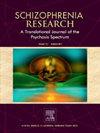Patterns of service utilization and its relation to outcome in a first-episode psychosis program
IF 3.5
2区 医学
Q1 PSYCHIATRY
引用次数: 0
Abstract
NAVIGATE is a comprehensive, manual-based intervention developed in the United States for young people experiencing first-episode psychosis (FEP). It comprises four core components: medication management, individual resilience training (IRT), supported employment and education (SEE), and a family psychoeducation program (FEP). This study aimed to describe NAVIGATE utilization patterns in Israel and their relationships to outcomes. Demographic and diagnostic information, service-utilization data, and functioning and symptom ratings were collected from clinical registries of 135 individuals who participated in NAVIGATE at three Israeli clinics from 2017 through 2021. The sample was mostly (72 %) men (M = 23.9 years old, SD = 5.4) who, on average, engaged in the program for more than 1 year. The IRT component was the most frequently attended (M = 25 sessions, SD = 24.9). Participants who attended more sessions in any component(s) showed higher functional and symptomatic improvement. Session intensity (by session intervals) was significant only for SEE: the more intensity, the more functioning and symptoms improved. Three distinct service-utilization clusters were identified: low use of all components; high IRT and low use of others; and moderate IRT, high FEP, and low others. The third cluster showed the highest improvement, but all clusters correlated with improved outcomes. The NAVIGATE program in Israel yield significant clinical and functional improvements across service-use patterns even when attendance was lower than the full offering. That a comprehensive, team-based intervention delivered flexibly can accommodate the rapidly changing needs of young people with FEP is encouraging, with important implications for policy and practice.
首发精神病患者服务利用模式及其与预后的关系
NAVIGATE是美国针对经历首发精神病(FEP)的年轻人开发的一种全面的、基于手册的干预措施。它包括四个核心部分:药物管理、个人恢复力训练(IRT)、就业和教育支持(SEE)和家庭心理教育计划(FEP)。本研究旨在描述以色列的导航使用模式及其与结果的关系。从2017年至2021年在以色列三家诊所参加NAVIGATE的135人的临床登记中收集了人口统计和诊断信息、服务利用数据以及功能和症状评分。样本主要为男性(72%)(M = 23.9, SD = 5.4),平均参与项目1年以上。IRT部分是参加频率最高的(M = 25次,SD = 24.9)。在任何组件中参加更多会议的参与者显示出更高的功能和症状改善。会话强度(按会话间隔)仅对SEE有显著意义:强度越大,功能和症状改善越多。确定了三个不同的服务利用率集群:所有组件的使用率都很低;高IRT和低其他使用;中等IRT,高FEP,低其他。第三组表现出最高的改善,但所有组都与改善的结果相关。以色列的导航项目在不同的服务使用模式中取得了显著的临床和功能改善,即使出勤率低于全部服务。一项全面的、以团队为基础的灵活干预措施能够适应快速变化的FEP青年需求,这是令人鼓舞的,对政策和实践具有重要意义。
本文章由计算机程序翻译,如有差异,请以英文原文为准。
求助全文
约1分钟内获得全文
求助全文
来源期刊

Schizophrenia Research
医学-精神病学
CiteScore
7.50
自引率
8.90%
发文量
429
审稿时长
10.2 weeks
期刊介绍:
As official journal of the Schizophrenia International Research Society (SIRS) Schizophrenia Research is THE journal of choice for international researchers and clinicians to share their work with the global schizophrenia research community. More than 6000 institutes have online or print (or both) access to this journal - the largest specialist journal in the field, with the largest readership!
Schizophrenia Research''s time to first decision is as fast as 6 weeks and its publishing speed is as fast as 4 weeks until online publication (corrected proof/Article in Press) after acceptance and 14 weeks from acceptance until publication in a printed issue.
The journal publishes novel papers that really contribute to understanding the biology and treatment of schizophrenic disorders; Schizophrenia Research brings together biological, clinical and psychological research in order to stimulate the synthesis of findings from all disciplines involved in improving patient outcomes in schizophrenia.
 求助内容:
求助内容: 应助结果提醒方式:
应助结果提醒方式:


